Triangles
In quadrilateral ACBD, AC = AD and AB bisects ∠A. Show that Δ ABC ≅ Δ ABD. What can you say about BC and BD?
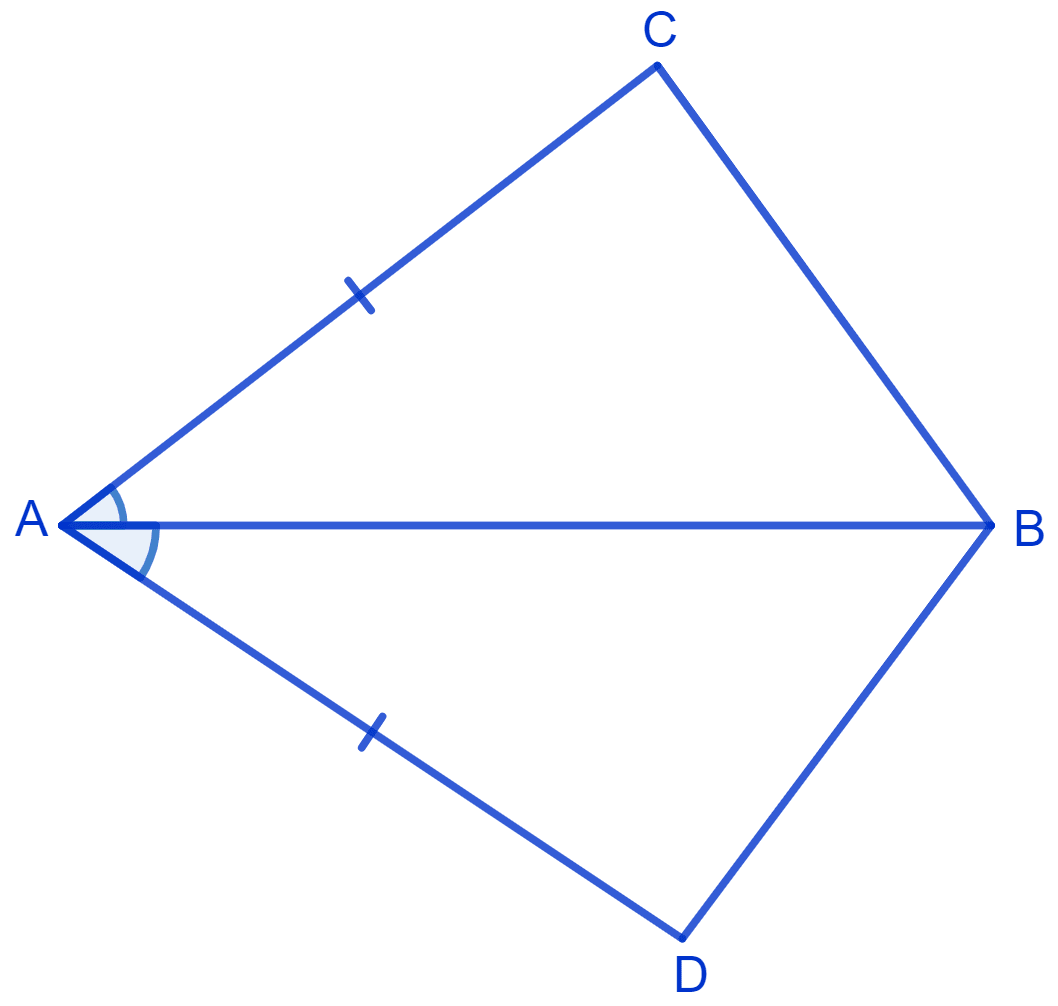
Answer
Given :
AC = AD
AB bisects ∠A i.e, ∠CAB = ∠DAB
In Δ ABC and Δ ABD
⇒ AB = AB (Common side)
⇒ ∠CAB = ∠DAB (Proved above)
⇒ AC = AD (Given)
∴ Δ ABC ≅ Δ ABD (By S.A.S. Congruence rule)
⇒ BC = BD (By C.P.C.T.)
Hence, BC and BD are of equal length.
ABCD is a quadrilateral in which AD = BC and ∠DAB = ∠CBA. Prove that
(i) Δ ABD ≅ Δ BAC
(ii) BD = AC
(iii) ∠ABD = ∠BAC
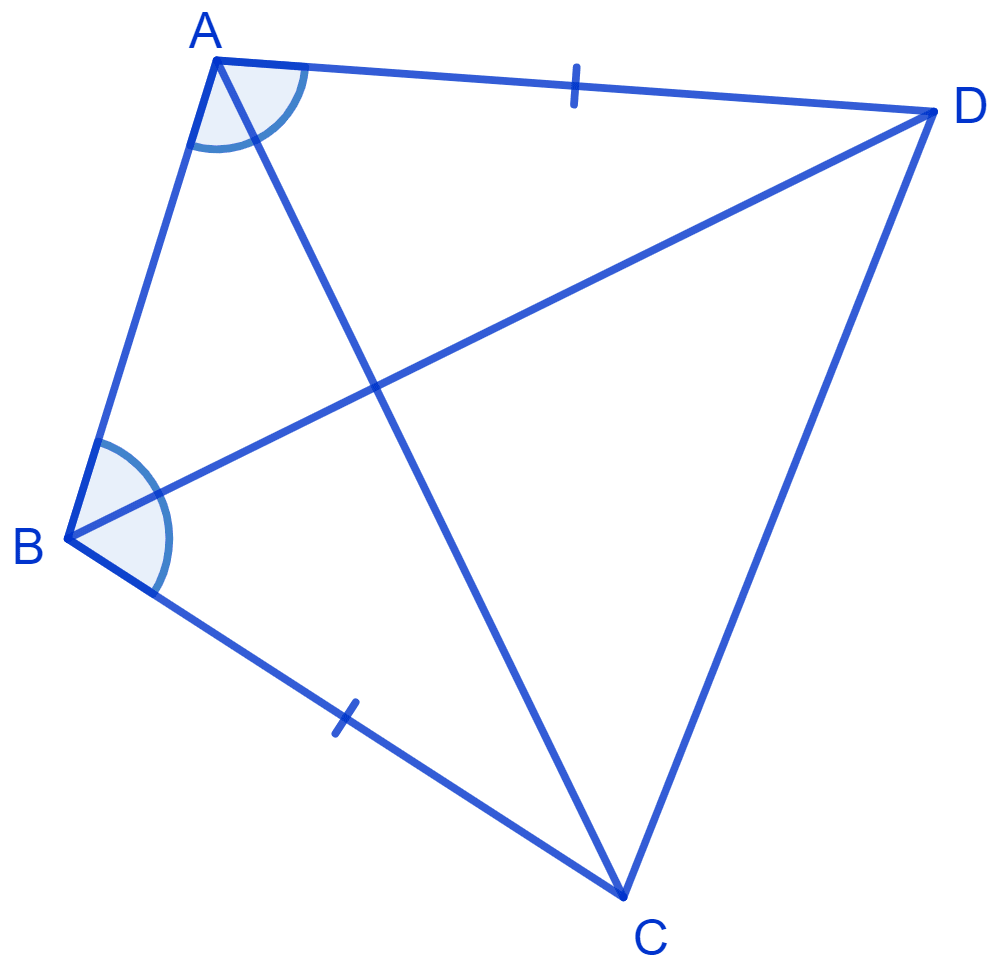
Answer
Given :
AD = BC and ∠DAB = ∠CBA
(i) In △ ABD and △ BAC,
⇒ AD = BC (Given)
⇒ ∠DAB = ∠CBA (Given)
⇒ AB = BA (Common side)
∴ △ ABD ≅ △ BAC (By S.A.S. congruence rule)
Hence, proved that △ ABD ≅ △ BAC.
(ii) As,
△ ABD ≅ △ BAC,
We know that,
Corresponding parts of congruent triangles are equal.
∴ BD = AC (By C.P.C.T.)
Hence, proved that BD = AC.
(iii) As,
△ ABD ≅ △ BAC,
We know that,
Corresponding parts of congruent triangles are equal.
⇒ ∠ABD = ∠BAC (By C.P.C.T.)
Hence, proved that ∠ABD = ∠BAC.
AD and BC are equal, perpendiculars to a line segment AB. Show that CD bisects AB.

Answer
Given :
⇒ AD = BC
From figure,
⇒ AD ⊥ AB, ∠OAD = 90°
⇒ BC ⊥ AB, ∠OBC = 90°
In △ BOC and △ AOD,
⇒ ∠BOC = ∠AOD (Vertically opposite angles are equal)
⇒ ∠OBC = ∠OAD (Each equal to 90°)
⇒ BC = AD (Given)
∴ △ BOC ≅ △ AOD (By A.A.S. congruence rule)
We know that,
Corresponding parts of congruent triangles are equal.
∴ BO = AO (By C.P.C.T.)
Hence, proved that CD bisects AB and O is the mid-point of AB.
l and m are two parallel lines intersected by another pair of parallel lines p and q. Show that Δ ABC ≅ Δ CDA.

Answer
Given :
l || m and p || q
In Δ ABC and Δ CDA,
⇒ ∠BAC = ∠DCA (Alternate interior angles are equal)
⇒ AC = CA (Common side)
⇒ ∠BCA = ∠DAC (Alternate interior angles are equal)
∴ Δ ABC ≅ Δ CDA (By A.S.A. congruence rule)
Hence, proved that Δ ABC ≅ Δ CDA.
Line l is the bisector of an angle ∠A and B is any point on l. BP and BQ are perpendiculars from B to the arms of ∠A. Show that:
(i) Δ APB ≅ Δ AQB
(ii) BP = BQ or B is equidistant from the arms of ∠A.

Answer
Given :
l is the bisector of an angle ∠A and BP ⊥ AP and BQ ⊥ AQ
(i) In Δ APB and Δ AQB,
⇒ ∠BAP = ∠BAQ (l is the angle bisector of ∠A)
⇒ ∠APB = ∠AQB (Each equal to 90°)
⇒ AB = AB (Common side)
∴ Δ APB ≅ Δ AQB (By A.A.S. congruence rule)
Hence, proved that Δ APB ≅ Δ AQB.
(ii) As,
Δ APB ≅ Δ AQB
We know that,
Corresponding parts of congruent triangles are equal.
∴ BP = BQ (By C.P.C.T.)
Hence, proved that BP = BQ or point B is equidistant from the arms of ∠A.
In figure, AC = AE, AB = AD and ∠BAD = ∠EAC. Show that BC = DE.

Answer
Given :
AC = AE, AB = AD,
⇒ ∠BAD = ∠EAC.
Adding ∠DAC to both sides of this equation, we get :
⇒ ∠BAD + ∠DAC = ∠EAC + ∠DAC
⇒ ∠BAC = ∠DAE.
In Δ BAC and Δ DAE,
⇒ AB = AD (Given)
⇒ ∠BAC = ∠DAE (Proved above)
⇒ AC = AE (Given)
∴ Δ BAC ≅ Δ DAE (By S.A.S. congruence rule)
We know that,
Corresponding parts of congruent triangles are equal.
∴ BC = DE (By C.P.C.T.)
Hence, proved that BC = DE.
AB is a line segment and P is its mid-point. D and E are points on the same side of AB such that ∠BAD = ∠ABE and ∠EPA = ∠DPB. Show that
(i) Δ DAP ≅ Δ EBP
(ii) AD = BE
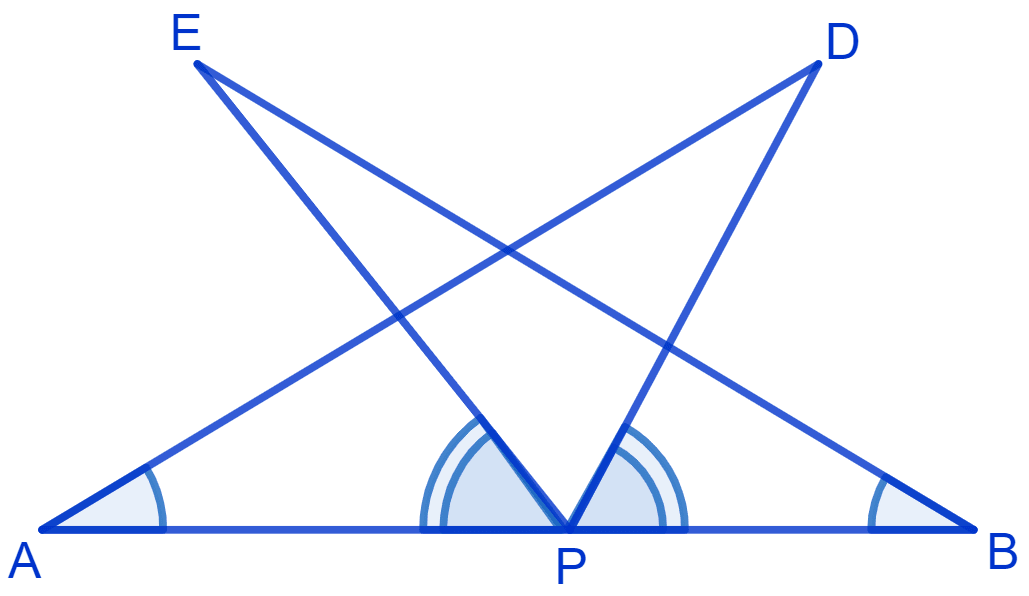
Answer
Given :
P is the mid-point of AB.
∴ AP = BP ......(1)
Given,
⇒ ∠BAD = ∠ABE .....(2)
From figure,
⇒ ∠BAD = ∠PAD and ∠ABE = ∠PBE
Substituting values in equation (2), we get :
⇒ ∠PAD = ∠PBE ........(3)
(i) Given,
⇒ ∠EPA = ∠DPB .........(4)
Adding ∠DPE to both sides of the above equation,
⇒ ∠EPA + ∠DPE = ∠DPB + ∠DPE
∴ ∠DPA = ∠EPB ......(5)
In Δ DAP and Δ EBP,
⇒ ∠PAD = ∠PBE [From (3)]
⇒ AP = BP [From (1)]
⇒ ∠DPA = ∠EPB [From (5)]
∴ Δ DAP ≅ Δ EBP (By A.S.A. congruence rule)
Hence, proved that Δ DAP ≅ Δ EBP.
(ii) As,
Δ DAP ≅ Δ EBP
We know that,
Corresponding parts of congruent triangles are equal.
∴ AD = BE (By C.P.C.T.)
Hence, proved that AD = BE.
In right triangle ABC, right angled at C, M is the mid-point of hypotenuse AB. C is joined to M and produced to a point D such that DM = CM. Point D is joined to point B. Show that :
(i) Δ AMC ≅ Δ BMD
(ii) ∠DBC is a right angle
(iii) Δ DBC ≅ Δ ACB
(iv) CM =

Answer
(i) In Δ AMC and Δ BMD,
⇒ AM = BM (M is the mid - point of AB)
⇒ ∠AMC = ∠BMD (Vertically opposite angles are equal)
⇒ CM = DM (Given)
∴ Δ AMC ≅ Δ BMD (By S.A.S. congruence rule)
Hence, proved that Δ AMC ≅ Δ BMD.
(ii) Since,
Δ AMC ≅ Δ BMD
∴ ∠ACM = ∠BDM (By C.P.C.T.)
From figure,
∠ACM and ∠BDM are alternate interior angles. Since alternate angles are equal, it can be said that DB || AC.
We know that,
Sum of co-interior angles = 180°.
⇒ ∠DBC + ∠ACB = 180°
⇒ ∠DBC + 90° = 180° [Since, ΔACB is right angled triangle at point C]
⇒ ∠DBC = 180° - 90°
∴ ∠DBC = 90°.
Hence, proved that ∠DBC is a right angle.
(iii) Since,
Δ AMC ≅ Δ BMD
∴ DB = AC (By C.P.C.T.)
In Δ DBC and Δ ACB,
⇒ DB = AC (Proved above)
⇒ ∠DBC = ∠ACB (Both equal to 90°)
⇒ BC = CB (Common)
∴ Δ DBC ≅ Δ ACB (By S.A.S. congruence rule)
Hence, proved that Δ DBC ≅ Δ ACB.
(iv) Since,
Δ DBC ≅ Δ ACB
⇒ AB = DC (By C.P.C.T.)
⇒ =
It is given that M is the midpoint of DC
⇒ CM = =
∴ CM =
Hence, proved that CM = .
In an isosceles triangle ABC, with AB = AC, the bisectors of ∠B and ∠C intersect each other at O. Join A to O. Show that :
(i) OB = OC
(ii) AO bisects ∠A
Answer
Given :
AB = AC

OB is the bisectors of ∠B
⇒ ∠ABO = ∠OBC = .
OC is the bisectors of ∠C
⇒ ∠ACO = ∠OCB = .
(i) It is given that in triangle ABC, AB = AC
⇒ ∠ACB = ∠ABC
Dividing both sides of equation by 2, we get :
⇒ ∠OCB = ∠OBC
We know that,
Sides opposite to equal angles of a triangle are also equal.
⇒ OB = OC.
Hence, proved that OB = OC.
(ii) In Δ OAB and Δ OAC,
⇒ AO = AO (Common)
⇒ OB = OC (Proved above)
⇒ AB = AC (Proved above)
∴ Δ OAB ≅ Δ OAC (By S.S.S. congruence rule)
We know that,
Corresponding parts of congruent triangles are equal.
⇒ ∠BAO = ∠CAO (By C.P.C.T.)
∴ AO bisects ∠A
Hence, proved that AO bisects ∠A.
In Δ ABC, AD is the perpendicular bisector of BC. Show that Δ ABC is an isosceles triangle in which AB = AC.
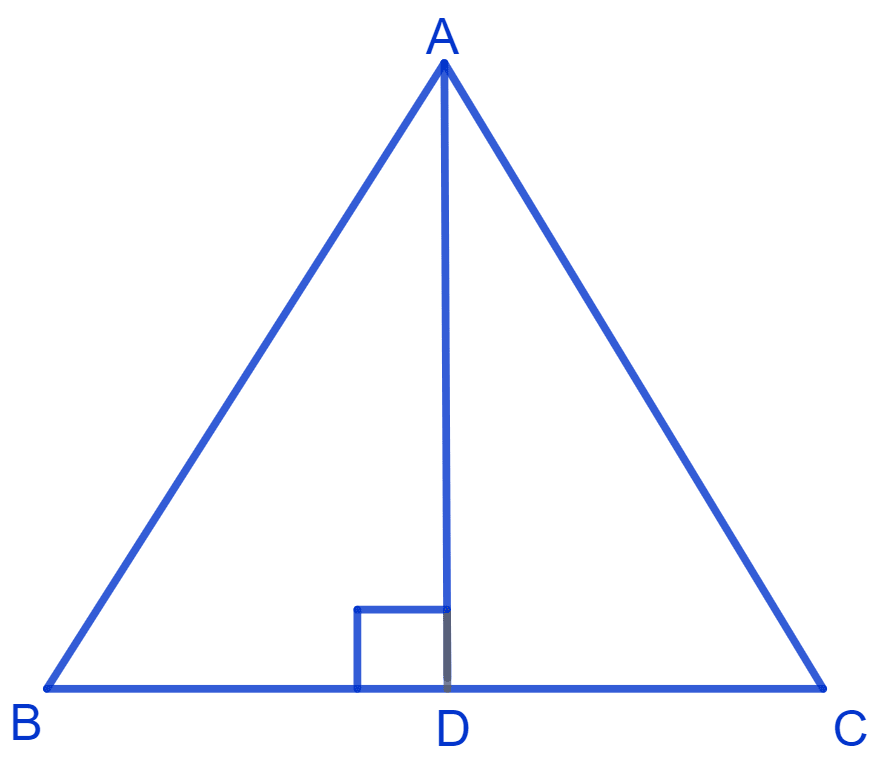
Answer
Given :
AD is the perpendicular bisector of BC.
∴ ∠ADB = ∠ADC = 90° and BD = DC.
In Δ ADC and Δ ADB,
⇒ AD = AD (Common side)
⇒ ∠ADC = ∠ADB (Each equal to 90°)
⇒ CD = BD (AD is the perpendicular bisector of BC)
∴ Δ ADC ≅ Δ ADB (By S.A.S. congruence rule)
We know that,
Corresponding parts of congruent triangles are equal.
∴ AB = AC (By C.P.C.T.)
Hence, proved that ABC is an isosceles triangle in which AB = AC.
ABC is an isosceles triangle in which altitudes BE and CF are drawn to equal sides AC and AB respectively see Fig. Show that these altitudes are equal.
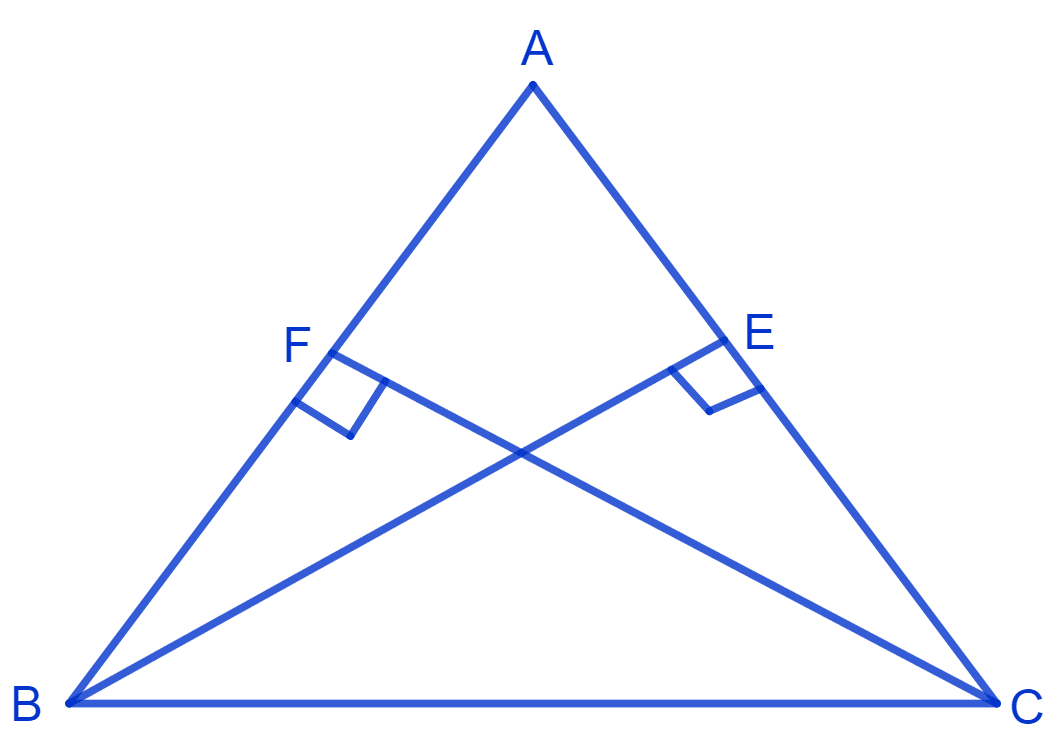
Answer
Given :
Δ ABC is an isosceles triangle with AB and AC as equal sides.
In Δ AEB and Δ AFC,
⇒ ∠AEB = ∠AFC (Each equal to 90° as BE and CF are altitudes)
⇒ ∠A = ∠A (Common angle)
⇒ AB = AC
∴ Δ AEB ≅ Δ AFC (By A.A.S. congruence rule)
We know that,
Corresponding parts of congruent triangles are equal.
∴ BE = CF (By C.P.C.T.)
Hence, proved that BE = CF.
ABC is a triangle in which altitudes BE and CF to sides AC and AB are equal. Show that
(i) Δ ABE ≅ Δ ACF
(ii) AB = AC, i.e., ABC is an isosceles triangle

Answer
Given :
BE = CF, where BE and CF are altitudes
So, ∠AEB = 90° and ∠AFC = 90°
(i) In Δ ABE and Δ ACF,
⇒ ∠AEB = ∠AFC (Each 90°)
⇒ ∠A = ∠A (Common angle)
⇒ BE = CF (Given)
∴ Δ ABE ≅ Δ ACF (By A.A.S. congruence rule)
Hence, proved that Δ ABE ≅ Δ ACF.
(ii) As,
Δ ABE ≅ Δ ACF
We know that,
Corresponding parts of congruent triangles are equal.
∴ AB = AC (By C.P.C.T.)
Hence, proved that ABC is an isosceles triangle with AB = AC.
ABC and DBC are two isosceles triangles on the same base BC. Show that ∠ABD = ∠ACD.
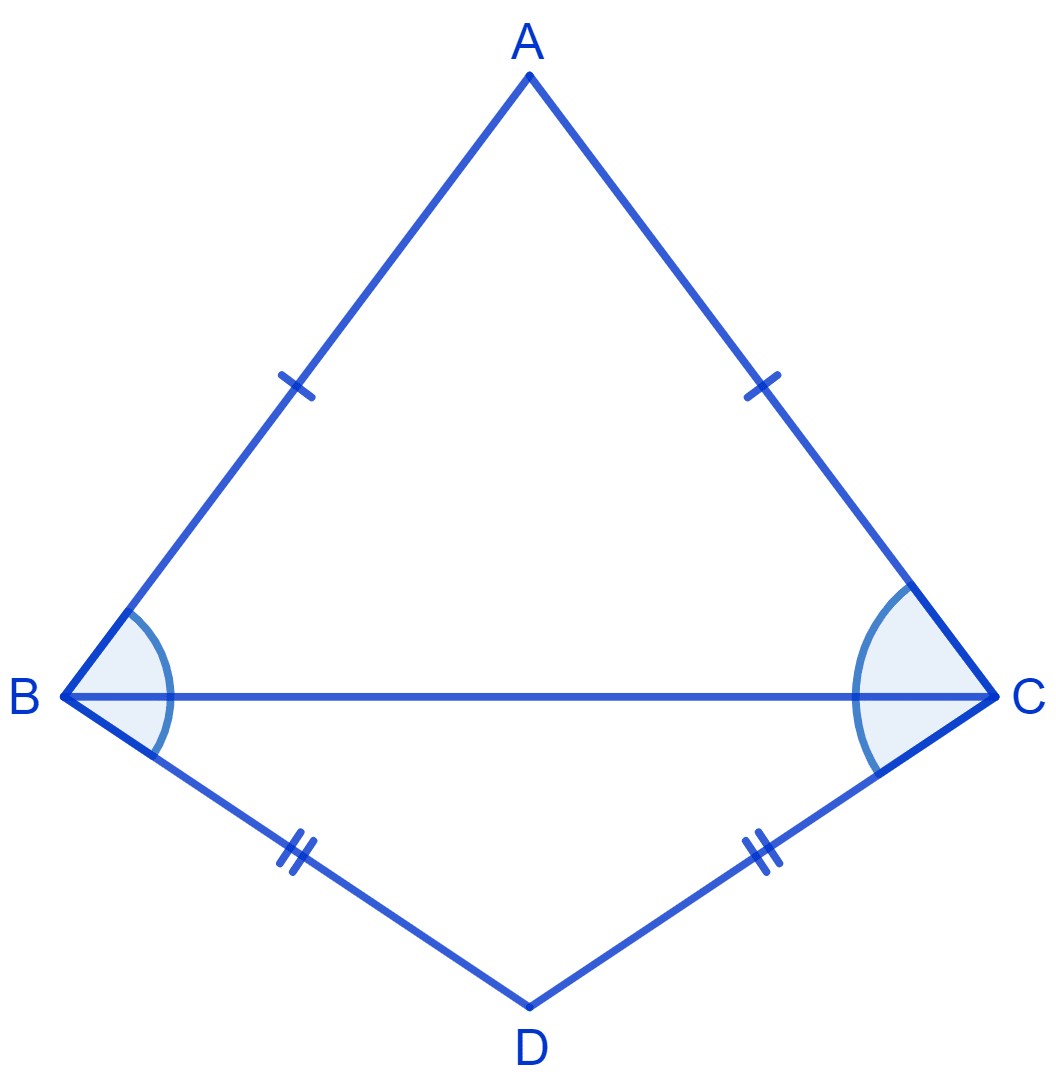
Answer
Given :
ABC and DBC are isosceles triangles.
Join AD.
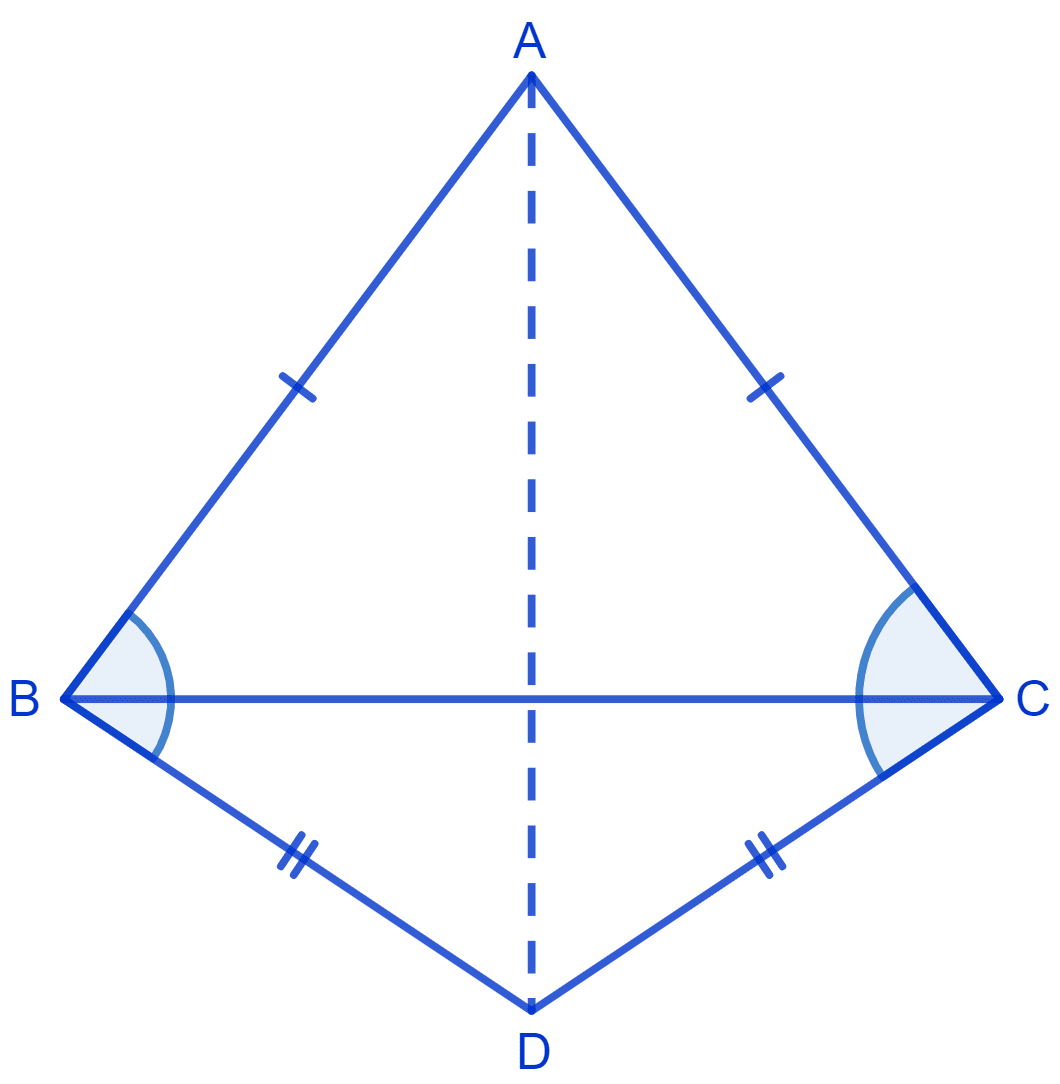
In △ DAB and △ DAC,
⇒ AB = AC (Given)
⇒ BD = CD (Given)
⇒ AD = AD (Common side)
∴ △ ABD ≅ △ ACD (By S.S.S. congruence rule)
We know that,
Corresponding sides of congruent triangles are equal.
∴ ∠ABD = ∠ACD (By C.P.C.T.)
Hence, proved that ∠ABD = ∠ACD.
Δ ABC is an isosceles triangle in which AB = AC. Side BA is produced to D such that AD = AB. Show that ∠BCD is a right angle.

Answer
Given :
⇒ AB = AC .......(1)
⇒ AD = AB ......(2)
From equation (1) and (2), we get :
⇒ AB = AC = AD
In an isosceles triangle ABC,
⇒ AB = AC
We know that,
Angles opposite to equal sides of a triangle are equal.
∴ ∠ACB = ∠ABC = x (let)
In Δ ACD,
⇒ AC = AD
We know that,
Angles opposite to equal sides of a triangle are equal.
∴ ∠ADC = ∠ACD = y (let)
From figure,
⇒ ∠BCD = ∠ACB + ∠ACD
⇒ ∠BCD = x + y .....(3)
In Δ BCD,
⇒ ∠ABC + ∠BCD + ∠ADC = 180° (Angle sum property of a triangle)
⇒ x + (x + y) + y = 180° [From equation (1), (2) and (3)]
⇒ 2(x + y) = 180°
Substituting value of (x + y) from equation (3) in above equation :
⇒ 2(∠BCD) = 180°
⇒ ∠BCD =
⇒ ∠BCD = 90°
Hence, proved that ∠BCD is a right angle.
ABC is a right angled triangle in which ∠A = 90° and AB = AC. Find ∠B and ∠C.
Answer
Given :
AB = AC and ∠A = 90°
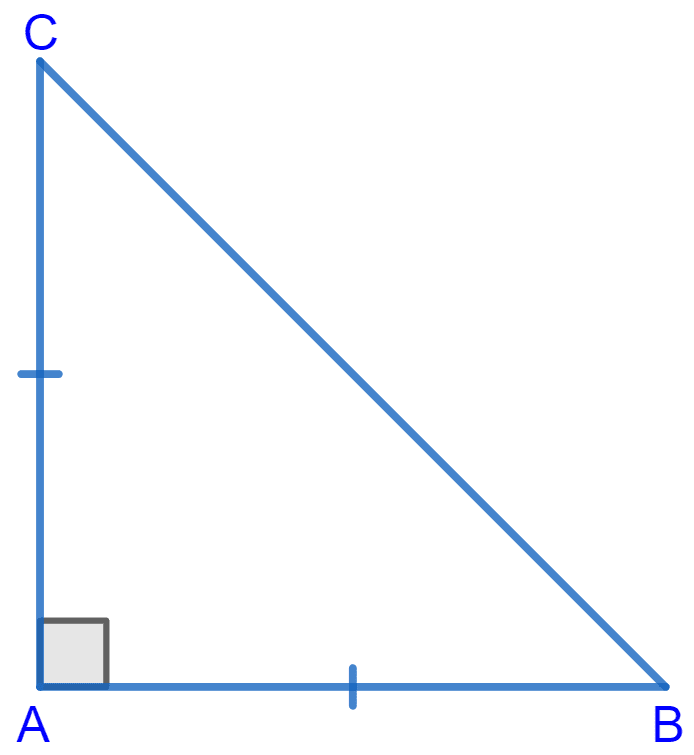
We know that,
Angles opposite to equal sides are also equal.
∠C = ∠B = x (let)
In Δ ABC,
⇒ ∠A + ∠B + ∠C = 180° (Angle sum property of a triangle)
⇒ 90° + ∠B + ∠C = 180°
⇒ 90° + x + x = 180° (From(1))
⇒ 2x = 180° - 90°
⇒ 2x = 90°
⇒ x =
⇒ x = 45°.
∴ ∠B = ∠C = 45°
Hence, ∠B = 45° and ∠C = 45°.
Show that the angles of an equilateral triangle are 60° each.
Answer
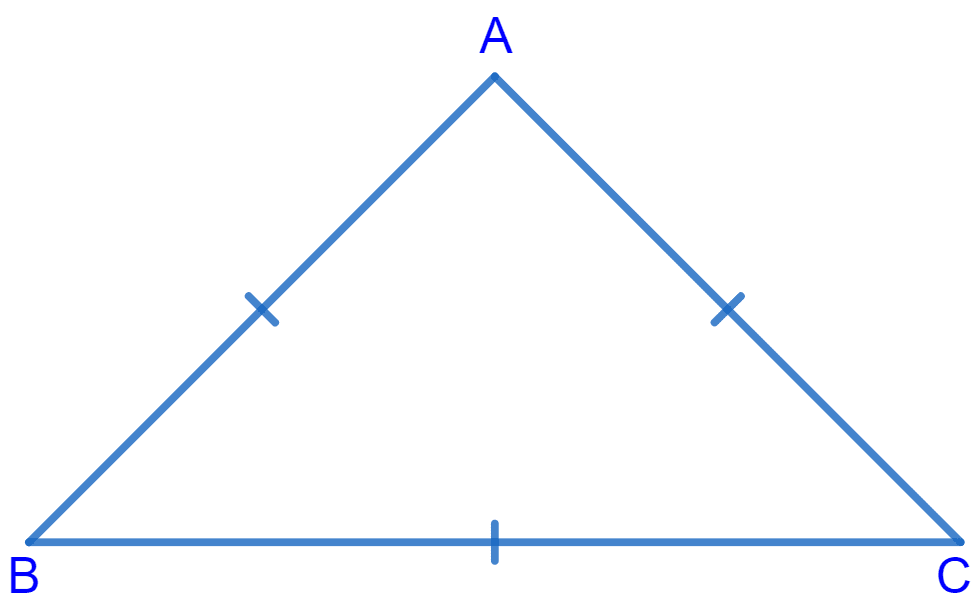
Construct a triangle ABC with AB = BC = AC.
In △ ABC,
AB = BC = AC
We know that,
Angles opposite to equal sides of a triangle are equal.
∴ ∠C = ∠A = ∠B = x (let)
In △ ABC,
⇒ ∠A + ∠B + ∠C = 180° (Angle sum property of a triangle)
⇒ x + x + x = 180°
⇒ 3x = 180°
⇒ x =
⇒ x = 60°.
∴ ∠A = ∠B = ∠C = 60°.
Hence, proved that the angles of an equilateral triangle are 60° each.
Δ ABC and Δ DBC are two isosceles triangles on the same base BC and vertices A and D are on the same side of BC. If AD is extended to intersect BC at P, show that
(i) Δ ABD ≅ Δ ACD
(ii) Δ ABP ≅ Δ ACP
(iii) AP bisects ∠A as well as ∠D
(iv) AP is the perpendicular bisector of BC

Answer
Given :
Δ ABC and Δ DBC are isosceles triangles on the same base BC.
∴ AB = AC and DB = DC
(i) In Δ ABD and Δ ACD,
⇒ AB = AC (Equal sides of isosceles Δ ABC)
⇒ BD = CD (Equal sides of isosceles Δ DBC)
⇒ AD = AD (Common)
∴ Δ ABD ≅ Δ ACD (By S.S.S. congruence rule)
Hence, proved that Δ ABD ≅ Δ ACD.
(ii) Since,
Δ ABD ≅ Δ ACD.
We know that,
Corresponding parts of congruent triangles are equal.
⇒ ∠BAD = ∠CAD ........(1)
From figure,
⇒ ∠BAD = ∠BAP and ∠CAD = ∠CAP
Substituting above value in equation (1), we get :
⇒ ∠BAP = ∠CAP ..........(2)
In Δ ABP and Δ ACP,
⇒ AB = AC (Equal sides of isosceles Δ ABC)
⇒ ∠BAP = ∠CAP [From equation (2)]
⇒ AP = AP (Common)
∴ Δ ABP ≅ Δ ACP (By S.A.S. congruence rule)
Hence, proved that Δ ABP ≅ Δ ACP.
(iii) Since,
Δ ABD ≅ Δ ACD
∴ ∠ADB = ∠ADC (By C.P.C.T.) ..........(3)
∴ ∠BAP = ∠CAP [From equation (2)]
∴ AP is the angle bisector of ∠A.
From equation (3),
⇒ ∠ADB = ∠ADC
⇒ 180° - ∠ADB = 180° - ∠ADC
⇒ ∠BDP = ∠CDP ......(4)
∴ AP is the bisector of ∠D
Hence, proved that AP bisects ∠A as well as ∠D.
(iv) In Δ BDP and Δ CDP,
⇒ DP = DP (Common side)
⇒ ∠BDP = ∠CDP [From equation (4)]
⇒ DB = DC (Equal sides of isosceles Δ DBC)
∴ Δ BDP ≅ Δ CDP (By S.A.S. congruence rule)
∴ ∠BPD = ∠CPD (By C.P.C.T.) .......(5)
From figure,
⇒ ∠BPD + ∠CPD = 180° (Linear pair)
⇒ ∠BPD + ∠BPD = 180° [From Equation (5)]
⇒ 2∠BPD = 180°
⇒ ∠BPD = 90° .......(6)
We know that,
⇒ BP = CP [Proved above]
Hence, proved that AP is the perpendicular bisector of BC.
AD is an altitude of an isosceles triangle ABC in which AB = AC. Show that
(i) AD bisects BC
(ii) AD bisects ∠A
Answer
Given :
Δ ABC is an isosceles triangle and AB = AC.
AD is altitude
∴ ∠ADB = ∠ADC = 90°.
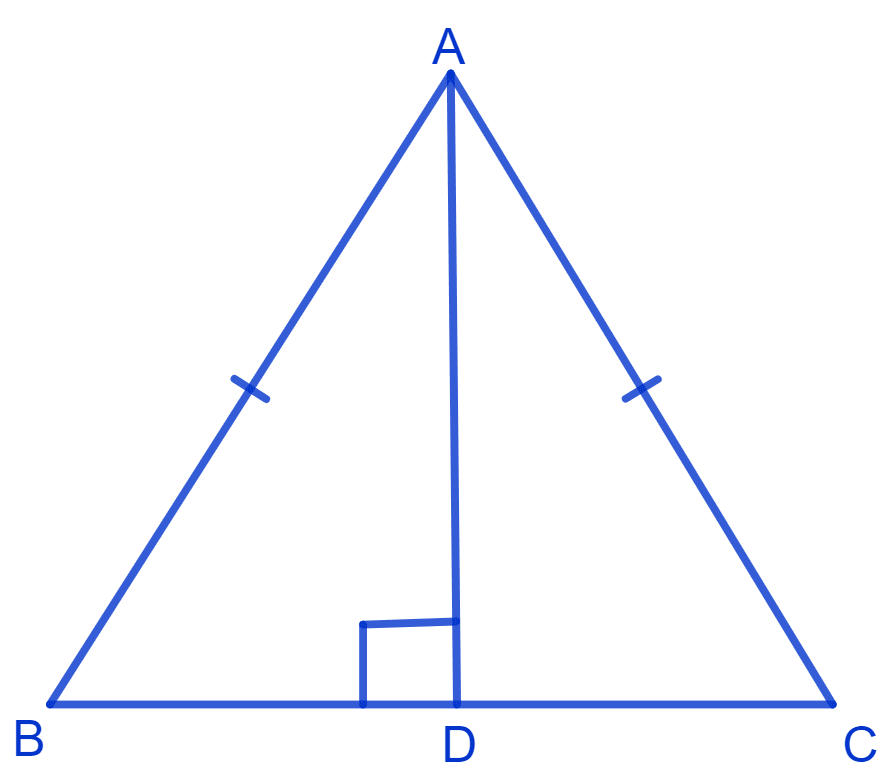
(i) In Δ BAD and Δ CAD,
⇒ ∠ADB = ∠ADC (Each equal to 90° as AD is altitude)
⇒ AB = AC (Given)
⇒ AD = AD (Common)
∴ Δ BAD ≅ Δ CAD (By R.H.S. Congruence rule)
We know that,
Corresponding parts of congruent triangles are equal.
∴ BD = CD (By C.P.C.T.)
Hence, proved that AD bisects BC.
(ii) Since, Δ BAD ≅ Δ CAD
∴ ∠BAD = ∠CAD (By C.P.C.T.)
Hence, proved that AD bisects ∠A.
Two sides AB and BC and median AM of one triangle ABC are respectively equal to sides PQ and QR and median PN of Δ PQR. Show that :
(i) Δ ABM ≅ Δ PQN
(ii) Δ ABC ≅ Δ PQR
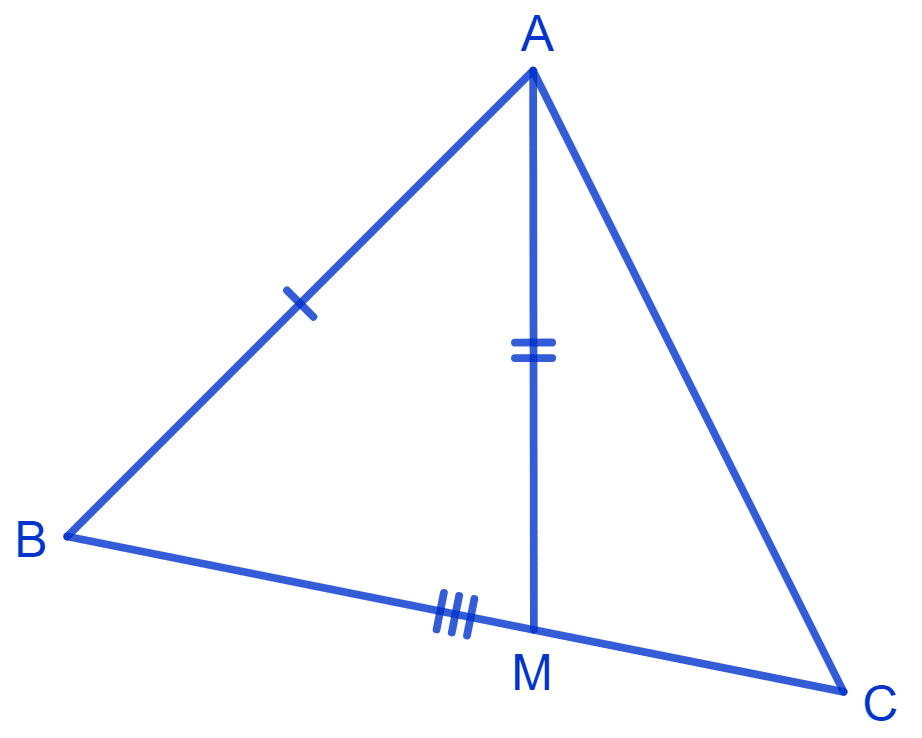
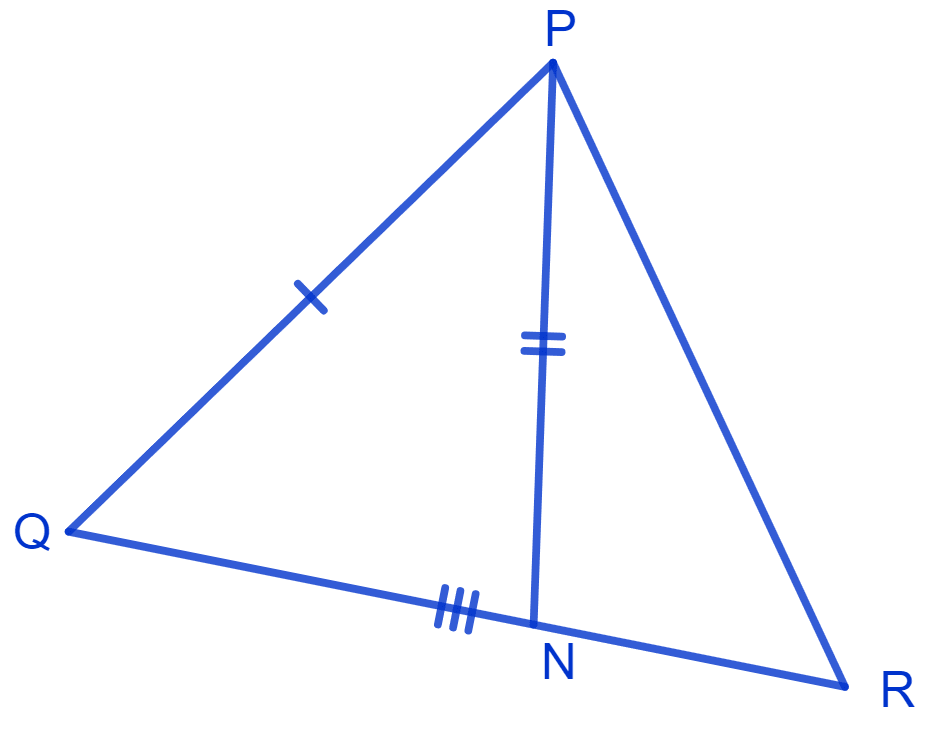
Answer
Given :
AB = PQ, BC = QR = x (let) and AM = PN.
(i) Given,
AM is the median of △ ABC
∴ BM = CM = .....(1)
Also, PN is the median of △ PQR
∴ QN = RN = ......(2)
From equation (1) and (2), we get :
BM = QN ..........(3)
Now, in △ ABM and △ PQN we have,
⇒ AB = PQ (Given)
⇒ BM = QN [From equation (3)]
⇒ AM = PN (Given)
∴ △ ABM ≅ △ PQN (By S.S.S. congruence rule)
Hence, proved that △ ABM ≅ △ PQN.
(ii) Since,
△ ABM ≅ △ PQN
We know that,
Corresponding parts of the congruent triangle are equal.
∠B = ∠Q (By C.P.C.T.) ...........(4)
Now, In △ ABC and △ PQR we have
⇒ AB = PQ (Given)
⇒ ∠B = ∠Q [From equation (4)]
⇒ BC = QR (Given)
∴ △ ABC ≅ △ PQR (By S.A.S. congruence rule)
Hence, proved that △ ABC ≅ △ PQR.
BE and CF are two equal altitudes of a triangle ABC. Using RHS congruence rule, prove that the triangle ABC is isosceles.
Answer
Triangle ABC with BE and CF as equal altitudes is shown in the figure below:

Given :
BE is a altitude.
∴ ∠AEB = ∠CEB = 90°
CF is a altitude.
∴ ∠AFC = ∠BFC = 90°
Also, BE = CF.
In Δ BEC and Δ CFB,
⇒ ∠BEC = ∠CFB (Each equal to 90°)
⇒ BC = CB (Common)
⇒ BE = CF (Given)
⇒ Δ BEC ≅ Δ CFB (By R.H.S. congruence rule)
We know that,
Corresponding parts of congruent triangle are equal.
⇒ ∠BCE = ∠CBF (By C.P.C.T.)
As,
Sides opposite to equal angles of a triangle are equal.
∴ AB = AC.
Hence, proved that Δ ABC is an isosceles triangle.
ABC is an isosceles triangle with AB = AC. Draw AP ⊥ BC to show that ∠B = ∠C.
Answer
Given :
Δ ABC is an isosceles with AB = AC.
Draw AP ⊥ BC,
∴ ∠APB = ∠APC = 90°

In Δ APB and Δ APC,
⇒ ∠APB = ∠APC (Each equal to 90°)
⇒ AB = AC (Since ABC is an isosceles triangle)
⇒ AP = AP (Common)
∴ Δ APB ≅ Δ APC (By R.H.S. congruence rule)
We know that,
Corresponding parts of congruent triangle are equal.
∴ ∠B = ∠C (By C.P.C.T.)
Hence, proved that ∠B = ∠C.